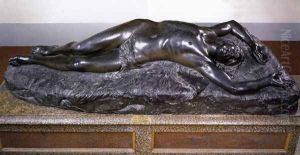Giovanni Dupre Paintings
Giovanni Dupré was an Italian sculptor, of the Neo-Classical and Romantic movements, born on March 1, 1817, in Siena, Italy. Despite his humble beginnings as the son of a woodcarver, Dupré demonstrated a remarkable talent for sculpture at a young age. He began his artistic education in Siena before moving to Florence, which was a vibrant center for the arts and home to a thriving community of sculptors, painters, and patrons.
In Florence, Dupré apprenticed under the sculptor Niccolò Bazzanti, and he later attended the Academy of Fine Arts. His skill quickly garnered attention, and he earned significant acclaim for his early work, 'Abel', which he completed in 1842. This work showcased his ability to convey deep emotion and exquisite detail in marble, qualities that would become hallmarks of his career.
Dupré's reputation continued to grow with subsequent works such as 'Cain', and he became a key figure in the Italian art scene. In 1850, he created one of his most famous sculptures, 'Giotto's Bell Tower', which was lauded for its intricate detail and historical significance. Throughout his career, Dupré received numerous commissions, including public monuments and religious sculptures, which were notable for their expressive realism and technical mastery.
His works were characterized by a strong sense of movement and a dedication to capturing the psychological depth of his subjects. Dupré's influence extended beyond his sculptures as he also wrote about art; his treatise 'Thoughts on Art' and his autobiography were well received and provided insights into his artistic philosophy and the broader Italian art world of his time.
Giovanni Dupré passed away on January 10, 1882, in Florence. His legacy is preserved in the enduring beauty of his sculptures and his contributions to the Italian Neo-Classical and Romantic movements. Today, his works can be found in museums, galleries, and public spaces throughout Italy and beyond, serving as a testament to his skill and artistic vision.







